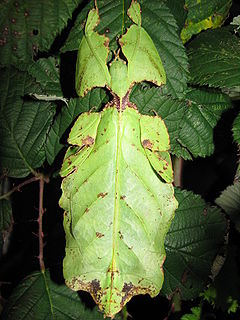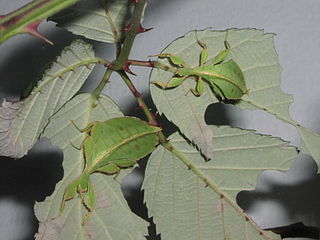
The family Phylliidae contains the extant true leaf insects or walking leaves, which include some of the most remarkably camouflaged leaf mimics (mimesis) in the entire animal kingdom. They occur from South Asia through Southeast Asia to Australia. Earlier sources treat Phylliidae as a much larger taxon, containing genera in what are presently considered to be several different families.

Pulchriphyllium giganteum, commonly known as the Giant Malaysian Leaf insect, is a species of leaf insects described from Malaysia by Hausleithner in 1984 and placed in the genus Pulchriphyllium since 2021. Pulchriphyllium giganteum is the largest species belonging to the genus Pulchriphyllium reaching 105 mm in size. They are found most abundantly in the west Malaysian tropics. The females typically have large elytra that lie edge to edge on the abdomen and tend to lack hind wings making them usually flightless. Males have small elytra and sometimes transparent non-leaflike functional hind wings. Pulchriphyllium giganteum found in the wild tend to be mostly females and the first male of this species was not found until 1994. In captivity, the species has primarily been observed to reproduce through parthenogenesis meaning the females are asexual. The primary reproductive pattern in the wild is unknown. Eggs tend to be brown or black and glossy and resemble the look of seeds. They hatch around 6 months after breeding. Newly hatched young nymphs tend to be wingless and brown or reddish in color. They develop their green color after feeding on leaves. Both the adult and larval stages are phytophagous meaning they feed on plants. The main plant food sources for this species are oak and bramble tree leaves.

Pulchriphyllium bioculatum, Seychelles leaf insect, Javanese leaf insect, or Gray's leaf insect, is a leaf insect of the family Phylliidae native to tropical Asia as well as Madagascar, Mauritius and the Seychelles. It was first described by George Robert Gray in 1832 and was the first phasmid he discovered. Leaf insects have extremely flattened, irregularly shaped bodies, wings, and legs. They are usually about 5–10 cm long. They are called leaf insects because their large, leathery forewings have veins that look similar to the veins on the particular type of leaves they inhabit. Its scientific name bioculatum means "two-eyed" and refers to the two dots located on the abdomen just in this species.
Charmides cerberus, is a species of phasmid or stick insect of the monotypic genus Charmides. It is endemic to Sri Lanka.
Lopaphus srilankensis, is a species of phasmid or stick insect of the genus Lopaphus. It is found in Sri Lanka. Two subspecies documented. It was first found from Anuradhapura.
Paramenexenus ceylonicus is a species of phasmid or stick insect of the genus Paramenexenus. It is found in Sri Lanka.
Paraprisomera coronata, is a species of phasmid or stick insect of the genus Paraprisomera. It is found in Sri Lanka.
Sipyloidea acutipennis is a species of phasmid or stick insect of the genus Sipyloidea. It is found in Sri Lanka.
Phobaeticus hypharpax, is a species of phasmid or stick insect of the genus Phobaeticus. It is found in Sri Lanka.
Phobaeticus lobulatus, is a species of phasmid or stick insect of the genus Phobaeticus. It is found in Sri Lanka.
Prisomera spinosissimum is a species of phasmid or stick insect of the genus Prisomera. It is found in India, Sri Lanka and Malaysia.
Ramulus ablutus, is a species of phasmid or stick insect of the genus Ramulus. It is found in Sri Lanka.
Cryptophyllium athanysus, is a species of phasmid or stick insect of the genus Cryptophyllium. It is found in Sri Lanka.

Phyllium hausleithneri, ore Hausleithner's stick insect, is a species of phasmid or leaf insect of the genus Phyllium. It is found in peninsular Malaysia, and Sri Lanka.
Pseudomicrophyllium geryon is a species of phasmid or leaf insect. It is found in the Philippines, Java (Indonesia), and Sri Lanka.
Sosibia passalus is a species of phasmid or leaf insect of the genus Sosibia. It is found in Sri Lanka.
Sosibia quadrispinosa, is a species of phasmid or leaf insect of the genus Sosibia. It is found in Sri Lanka.

Phyllium bilobatum is a species of leaf insect in the family Phylliidae. It is found in the Philippines and Malaysia. This species was first described in 1843 by the English zoologist George Robert Gray, who gave it the name Phyllium bilobatum. It has been assigned to the subgenus Phyllium, which is to be distinguished from the second subgenus Pulchriphyllium, within the genus Phyllium. The holotype is a female from the Philippines, which is kept in the Natural History Museum, London where Gray worked cataloguing insects.

Cryptophyllium is a new (2021) genus of leaf insects in the tribe Phylliini. The current distribution is probably incomplete, but includes southern China, Sri Lanka, Indo-China, Malesia and western Pacific islands.





